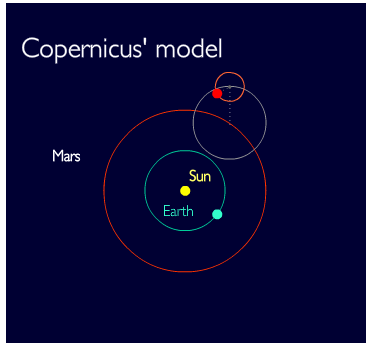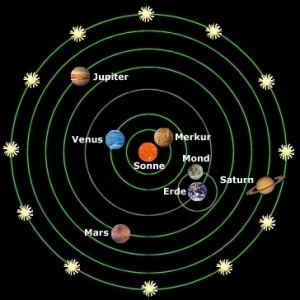|
|
Remember these guys?

Aristotle stands in the Greek philosophical tradition which asserts that nature is understandable. This tradition, opposed to the idea that nature is under the control of capricious (MAGIC) deities which are to be appeased rather than understood, is one of the roots (PHYSICS) of science.
Okay, our task is to now remove the earth from the center of the Universe and come up with something more sensible because the model doesn't match the observations:
Elements of the Universe at this time (Aristotle):
Problems:
 attributed to disturbances in the upper atmosphere of the earth
attributed to disturbances in the upper atmosphere of the earth
 all planets
and stars should move in the same direction due to the initial action of the
Prime Mover.
But Mars was known at that time to sometimes move in the opposite direction
for a brief period of time (retrograde motion)
all planets
and stars should move in the same direction due to the initial action of the
Prime Mover.
But Mars was known at that time to sometimes move in the opposite direction
for a brief period of time (retrograde motion)

Cusa and Copernicus
Cardinal Nicholas of Cusa (15th Century) used the Socratic Method
"All I know is that I know nothing" and concluded that the mind can only understand things by relation - there are no "absolutes".
In his book "On Learned Ingorance" several ideas emerge about the Universe:
Thus for the first time we see the ideas of relativity, homogeneity and
non-uniqueness expressed.
The origin of original ideas are difficult to pin down. Often its the
marketing that wins out! Our man Copernicus seems to have marketed the
non-uniquess idea quite well:

 However, ARISTARCHUS OF SAMOS did think of this idea first.
However, ARISTARCHUS OF SAMOS did think of this idea first.

The New Idea of the Universe
This is the First Heliocentric Cosmology
This also gives a natural explanation for the observed retrograde motion that Ptolemy struggled with:

Also this explained the variation in brightness observed for Mars. But the model wasn't perfect. Copernicus, didn't understand how the larger brightness variations observed in Venus could be accounted for. That is, he did not understand that Venus would have phases:

Copernicus also did not know what to do with the stars and essentially left them fixed on some distant crystalline sphere. Copernicus also retains the Aristotelian notion of perfection and requires all the orbits of the planets (around the sun) to be perfectly circular. Within the accuracy of naked eye observations of the time, there was no way to clearly disprove this. In the end, his models still depended on epicycles:

 meaning that this model had good predictive power.
meaning that this model had good predictive power.

Goethe's Comment on Copernicus:"Of all discoveries and opinions, none may have exerted a greater effect on the human spirit than the doctrine of Copernicus. The world had scarcely become known as round and complete in itself when it was asked to waive the tremendous privilege of being the center of the universe. Never, perhaps, was a greater demand made on mankind - for by this admission so many things vanished in mist and smoke! What became of our Eden, our world of innocence, piety and poetry; the testimony of the senses; the conviction of a poetic - religious faith? No wonder his contemporaries did not wish to let all this go and offered every possible resistance to a doctrine which in its converts authorized and demanded a freedom of view and greatness of thought so far unknown, indeed not even dreamed of." |